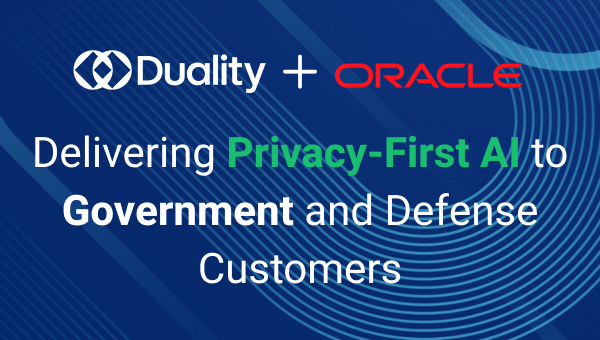Full steam ahead. Complete mobilization. The power of people coming together to solve tough problems is described in many ways, but the results are always the same: solutions are found. Proof and point, the US Whitehouse recently included a specific focus on collaboration to solve problems, albeit in the context of security. 23andMe and Ancestry are the largest, direct-to-consumer DNA collectors in the world and what they’re doing is massive for teams researching genomic data – there’s no comparable collection of this type of data in terms of both volume and diversity. The importance of such analysis is the reason public cloud providers are working tirelessly to provide a “safe place” for the mass aggregation and analysis of healthcare data; aka “security clouds”. Today, healthcare companies often operate in silos, with limited collaborative abilities within a single country let alone on a global scale. As we covered in part one of this series, all of the major healthcare M&As over the last 10 years have been in support of initiatives that require data collaboration across lines of business, jurisdictions, or both. To understand the importance and difficulty in such collaborations, it’s important to understand healthcare data ownership: the relationship between data analysis technologies and those who actually own the data.
The Tech
The buzzwords around data analytics are business intelligence (BI), machine learning (ML), and artificial intelligence (AI). Without going too deep, here’s a basic overview of the technology and some considerations one should take into account when evaluating them:
First, these terms are invoked rather loosely in the buzzword bingo game companies are forced to play, called SEO/SEM. Be sure to ask “how” ML and AI are used rather than accepting the terms at face value, and focus on the quality and speed of outputs rather than the underlying technology used to get there.
Second, you don’t simply summon “AI” out of a magic LAMP (if you know, you know), pack up your bags, and let the genie do the work. Like any software, developing these models requires the time of specialized engineers and data scientists to continuously train and improve models to attain acceptable levels of efficacy (in healthcare, the degree to which an intervention, procedure, or treatment is successful in producing a desired outcome).
Third, achieving high efficacy requires large volumes of diverse data in reducing bias. In this context, a bias is similar to a bug. A problem. For example, a bias in Apple’s facial recognition meant that this feature didn’t work for populations with low representation in the data used to develop and train the model. Now, imagine a bias that misdiagnoses a patient and prescribes an ineffective treatment (or worse yet, one that exacerbates the issue or creates a new one).
For a more technical dive, check out this whitepaper by Osterman explaining how to improve ML model training using secure, collaboration technology. The takeaway is that while we have the analysis tech we need, our data analysis tool sets are only as good as the data with which we can train them. This leads us to our next topic, healthcare data ownership.
Healthcare Data Ownership: A Breakdown
Understanding how to apply “teamwork makes the dream work” across an entire healthcare system requires knowing a bit about the “team.” Here’s a high-level summary of the key players in the US healthcare system when it comes to healthcare data ownership:
- Patients – You. Me. Everyone. We have information about ourselves which is critical for healthcare professionals to do their jobs (even though not all data can be measured – like diet, chronic pain, or stress). Most of this data is collected manually, at visits with your doctor, through surveys, or via phone calls. A big change to patient data is the introduction of IoT – connected devices like wearable heart rate monitors, smart beds, blood sugar meters, smart medication dispensers, smart scales, etc. IoT supports many health initiatives by improving the frequency and accuracy of data and communication with patients.
- Healthcare Providers – Our doctors, nurses, therapists, midwives, hospice care workers, etc. These are the people who patients interact with directly. Healthcare providers are the primary collectors of patient healthcare data and real-world data (RWD). Their ability to quickly access studies and insights improves the quality of care they can provide, especially concerning preventative health. A common initiative is to improve the frequency and breadth of patient data collected. Pharmacies, insurance companies, research teams, and drug manufacturers all benefit from access to the data collected by care providers.
- Pharmacies – Pharmacies take prescriptions (written by providers), ensure no conflicts with existing medications, provide some guidance to the patient, and have insights into non-adherence indicators like not refilling a prescription on time. However, pharmacies are largely disconnected from more specific patient data and must utilize manual outreach to patients directly.
- Pharmacy Benefit Managers (PBM) – This is a middleman role often contracted by health insurers. The PBM’s role is to evaluate and manage drug costs, design and collect rebates from drug manufacturers (often, retaining a portion of the rebates as part of their compensation), and negotiate with pharmacies over reimbursement for drugs and various fees.While they don’t collect or own data, they benefit from analyzing data held by others.
- Health Insurance Companies – US Health Insurance companies design coverage plans and approve the use of those plans via claims. Healthcare providers and pharmacies submit claims for services rendered. The insurer ensures there are no duplicates or fraud, and that the claims are covered by the patient’s plan. This means collecting patient-specific data about procedures, medications, etc., and their respective costs. In addition to validating the claims, this information helps understand the impacts of specific treatments for various issues at a population and individual level. The volume of claims and adjoining clinical data to substantiate those claims are also useful in prioritizing attention from other players, like drug manufacturers, pharmacies, genomic data research teams, and care providers.
- Research Teams – Often a part of universities, specialized institutes, and government bodies, these organizations are on the front lines of healthcare innovation. They are often primary data analyzers from which other parts of the “healthcare team” can make prioritizations and decisions. Unfortunately, they must rely upon access to data collected and controlled by other organizations.
- Drug Manufacturers – The core of modern medicine. These organizations prioritize, evaluate, and create drugs to address health symptoms and underlying problems which are then prescribed by care providers and delivered via pharmacies. Big pharma organizations benefit massively from being able to analyze aggregated data on specific populations for prioritization of which drugs or prioritize. In addition, individual patient records are valuable as part of their real-world evidence and stage 4 clinical trial operations, among others: drug efficacy, side effects, etc.
We have the tools and know how to use them. We know who has useful data. We know who should collaborate to achieve these major health and business objectives. But the reality is that collaboration across these stakeholders is largely still manual and piecemeal, or doesn’t happen at all. In the next post, we’ll cover the regulatory and technical challenges faced when sharing and collaborating in healthcare.

















